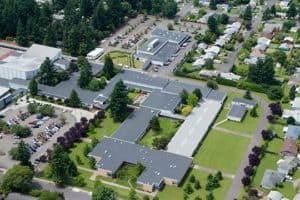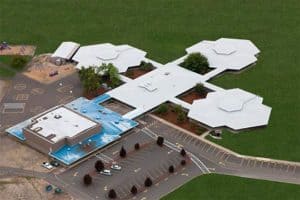Submitted by: Eileen Dutton, member of the Communications, Marketing and Education Committee for ARMA
Low-slope asphalt roofing has been around for more than 100 years, but the technology it utilizes is continually advancing. Through scientific research and development, low-slope asphalt roofing has evolved to improve durability, reliability and performance. The original Built-Up Roofs (BUR) were made using naturally-occurring asphalt with cotton rags as the reinforcement. As the oil refining process improved, petroleum-based asphalt was used with the cotton rag felts. In the 1920s, when cotton rags were in short supply, wood and cellulose fiber became the predominant materials used for reinforcementi. ASTM D2178, Standard Specification for Asphalt Glass Felt Used in Roofing and Waterproofingii, provides minimum physical properties for Type IV and VI felt sheets that are used in traditional BUR systems.
In the 1950s, glass felts were being considered for use as reinforcement for low slope roofing, but it took another 20 years for fiberglass technology to actually begin being used in these systems. Fiberglass mat plants were first built in Europe; the first was installed in the United States in 1975. The fiberglass-based BUR systems that many consider to be “old” are only about 40 years old. The redundancy of the multi-ply system that protected roofs for years changed with the introduction of fiberglass technology. This new material resulted in better protection from moisture and reduced cracking in the field. But that was only the beginning of the low slope BUR metamorphosis.

David Douglas High School in Portland, Oregon, uses a traditional four ply built up roofing (BUR) system with a modified cap sheet set in hot asphalt.
The United States again looked abroad and saw that Europeans were using a modified asphalt technology, Atactic Polypropylene (APP), a thermoplastic polymer that is still used to modify roofing asphalt. The original APP material used when blending first started in the 1970s was a waste product from the manufacture of isotactic polypropylene. Large stockpiles of APP were found buried in the earth and cleaned for use in asphalt. Its use became widespread because it proved to be flexible yet durable, making it resistant to cracking due to the material’s improved low-temperature properties. However, due to its high demand, the stockpile of APP soon ran low. These products were originally sold as a single-ply roofing material, but eventually they were installed as multi-ply systems, with a minimum of a base sheet and a smooth surfaced or granulated cap sheet. The APP-modified bitumen sheets used today utilize APP polymers made specifically for the roofing industry, and the APP polymers are often blended to maintain optimum properties on the roof. APP membranes are heat-fused, most commonly by torch application, but may also be fused with hot air. Some APP membranes may be installed using a cold-applied adhesive, but this method is less common. APP membranes are popular on multi-story buildings, as the rolls and the torch or heat welder can be transported easily to the roof.
After the APP roofing membranes were released, styrene-butadiene-styrene (SBS) began to be manufactured in the United States. SBS membranes exhibit a higher degree of elasticity than APP membranes. SBS membranes are installed in hot-applied, cold-applied, heat-fused or self-adhering (SA) systems. SBS modified bitumen membranes are also offered as a multi-ply system, using a base sheet, a ply sheet and a granulated cap sheet. SBS membranes have excellent high- and low-temperature flexibility.
These modified membranes are all durable and use either glass-fiber mats, polyester mats or a combination of both. The sheets rely on both the polymer and the different mats for their strength. Polymers impart better impact resistance to the membranes, as well as better low temperature properties.

This elementary school in White City, Oregon, chose a modified bitumen roofing system that utilizes tapered insulation.
APP membranes are covered by three ASTM standards: ASTM D6222, Standard Specification for Atactic Polypropylene (APP) Modified Bituminous Sheet Materials Using Polyester Reinforcements; ASTM D 6223, Standard Specification for Atactic Polypropylene (APP) Modified Bituminous Sheet Materials Using a Combination of Polyester and Glass Fiber Reinforcements; and ASTM D6221, Standard Specification for Reinforced Bituminous Flashing Sheets for Roofing and Waterproofing, which covers flashing materials made with both APP and SBS.
SBS membranes are covered by three other ASTM standards: ASTM D6162, Standard Specification for Styrene Butadiene Styrene (SBS) Modified Bituminous Sheet Materials Using a Combination of Polyester and Glass Fiber Reinforcements; ASTM D6163 Standard Specification for Styrene Butadiene Styrene (SBS) Modified Bituminous Sheet Materials Using Glass Fiber Reinforcements; and ASTM D6164, Standard Specification for Styrene Butadiene Styrene (SBS) Modified Bituminous Sheet Materials Using Polyester Reinforcements.
Adhesives are used to hold low-slope asphalt roofing systems together. The most common adhesive is a hot-mopping asphalt that meets ASTM D312, Standard Specification for Asphalt Used in Roofing. There are different types of mopping asphalt available; some use an odor or fume suppressant. These asphalt products are significantly less bothersome to building occupants or neighbors. In addition, the roofing industry has developed modified asphalts that reduce the odor itself. Some of these include SEBS mopping asphalts that meet ASTM D6152, Standard Specification for SEBS-Modified Mopping Asphalt Used in Roofing; others are proprietary wax–asphalt blends that meet ASTM D312. Use of an ASTM D6152 asphalt with SBS membranes produces a tough system that is durable and passes ASTM D5849, Standard Test Method for Evaluating Resistance of Modified Bituminous Roofing Membrane to Cyclic Fatigue (Joint Displacement). Cold adhesives are available from a variety of manufacturers, with many meeting even the most stringent South Coast Air Quality Management District SCAQMD VOC (volatile organic compound) regulations. Self-adhering (SA) membranes are manufactured in roll form, with a high grade commercial adhesive on one side. During the manufacturing process the adhesive is covered with a protective film that an installer later peels away to expose the adhesive. Over the last 15 years SA roofing has made inroads with installers due to its reputation for being clean, easy and safe. These advantages are useful on installations where occupant comfort is extremely important – such as healthcare and educational facilities, and in instances where access to the roof is limited – such as high-rise buildings.
Multi-ply systems have also advanced to meet various energy efficiency and environmental regulations, such as ENERGY STAR. There are multiple membranes available that have high reflectivity and meet or exceed the minimum initial 65 percent reflectivityiv required for factory-painted surfaces, highly reflective granules or laminated film surfaces to achieve the ENERGY STAR rating. In addition, a variety of field-applied coatings are available through the membrane manufacturers or third-party coating manufacturers. These usually consist of acrylic or elastomeric acrylic coatings, but other technologies are available. Check with the roof membrane manufacturer before using a coating to be sure it is compatible and won’t void the warranty.
BUR and modified bitumen systems have demonstrated a proven reliability for many years. Research and technology continue to develop ways to make these systems stronger, easier to install, and easier to clean. The redundancy and reliability exhibited by these systems is what makes them so attractive, particularly in areas that have harsh climates. When costs and ease of repair are consideredv, BUR systems are the smart choice.
For more information on asphalt roofing, please visit www.asphaltroofing.org.
i docserver.nrca.net/pdfs/technical/1815.pdf, William Cullen, “Research and Performance Experience of Asphalt Shingles”, 10th Conference on Roofing Technology
ii www.astm.org
iii www.astm.org
iv Roof Products Program Requirements by Energy Star
v www.rci-online.org/interface/2004-06-scheirer-corbin.pdf, Built Up Roof Remains Popular

